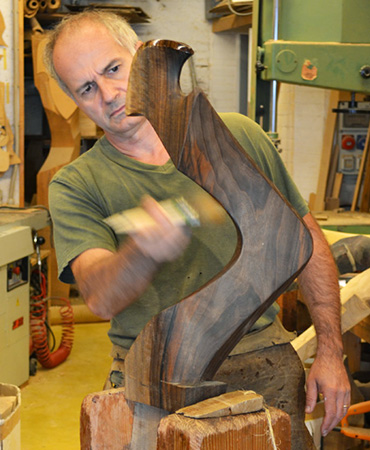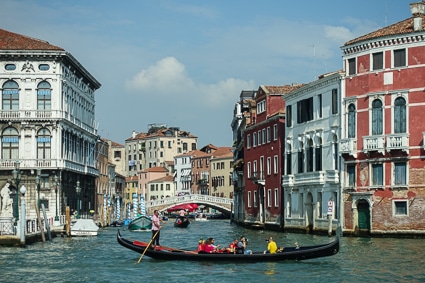There is no other image that more identifies Venice than the gondola. Its unique design dates back to the 11th century. The gondola has been celebrated in song, art and literature for centuries. Mark Twain observed, “We reached Venice at eight in the evening, and entered a hearse belonging to the Grand Hotel d’Europe. At any rate, it was more like a hearse than anything else, though to speak by the card, it was a gondola. And this was the storied gondola of Venice!–the fairy boat in which the princely cavaliers of the olden time were wont to cleave the waters of the moonlit canals and look the eloquence of love into the soft eyes of patrician beauties, while the gay gondolier in silken doublet touched his guitar and sang as only gondoliers can sing! This the famed gondola and this the gorgeous gondolier! – the one an inky, rusty old canoe with a sable hearse-body clapped on to the middle of it, and the other a mangy, barefooted guttersnipe with a portion of his raiment on exhibition which should have been sacred from public scrutiny. Presently, as he turned a corner and shot his hearse into a dismal ditch between two long rows of towering, untenanted buildings, the gay gondolier began to sing, true to the traditions of his race.”(The Innocents Abroad )

A few years ago, I visited Venice’s most famous gondola builder or squero. The term squero derives from the word “squara” which indicates a team of people who work together to build boats. The Squire di San Trovaso rises along the homonymous river and dates back to before the seventeenth century. I wanted to see firsthand how gondolas are made. I was shown the hundred-year-old jigs in which the frames are set and the whole process right up to painting the banana-shaped hull. However, there was none of the oar locks or forcola used by every gondolier to row and adroitly control the gondola. I learned that the making of the forcola is a separate and very special skill. The manager of the squero directed me to the most respected forcola maker in Venice, Saverio Pastor.
In his teens, Pastor apprenticed under the legendary “Forcola King” Giuseppe Carli. By the 1980s he had his own shop where he made forcola and oars. As a master remer, Pastor uses some of the traditional tools which have been used over the centuries to shape the forcola and passed onto him by his mentor. His skill and experience make it possible for him to create a design unique to the gondoliers who daily ply the water of Venice as well as those who compete in gondola regattas. Pastor is a true Venetian and loves his city very much. He is the founder of the “El Felze” association which includes all of the craftsmen involved in the construction of a gondola. He also is part of the council of Arzana, an association for the study and preservation of the historical Venetian boats.
Pastor worked as we talked amid the delightful aroma of wood chips. Pastor said that the shape of the forcola was critical to the ability of the gondolier to propel the boat. Each curve and angle had a precise function. The forcola for a gondola (as compared with other Venetian boats) offers a rower eight different points of contact for the oar, each devised for different maneuvers and different ways of making the boat go forward, backward, turn, or stop, according to the given situation. The gondoliers make it look easy but actually, it takes great skill to properly use the oar in just the right way on the forcola. This device is essentially a second-class lever, for which the point of resistance is the water. It makes it possible for a gondolier facing forward to maneuver a 36 foot, 750 lb. boat. The forcola design is a triumph of naval efficiency — an Italian study showed that the amount of energy a gondolier expends to paddle him and two passengers is equal to the energy expended by one person walking at the same speed.

Pastor also creates oars that are specially designed for the gondolier. The oar is described on the LeForcole website as follows, “The oars used in Venetian rowing have a fairly simple form but they must have certain characteristics and precise details to optimize this unique style of rowing. The central shaft in ramin is made of a long cylinder (man e giròn) inserted into the trapezoidal blade with two lateral trims in beech (corteli). The shaft is not a perfect cylinder but has an oval section that tapers to form the handle of the oar. The blade is asymmetrical: the top side has an edge (spina), angled towards the stern, which strengthens the blade and helps to maintain the direction of the stroke of the oar; the bottom side of the blade is rounded. The edge at the extremity of the blade must have a perfect curvature to ‘cut’ the water efficiently, while the blade as a whole has a slight spoon-like curvature when viewed from the side.
The asymmetry of the blade defines which side of the boat the oar is used on: remi popieri are oars used on the starboard side while remi provieri are used on the port side. The length and diameter of the oar depend on the rowing position of the oarsman in the specific type of boat: from light, 3-meter long oars for rowing alla valesana (two oars rowed by a single oarsman), to the ‘heavy- duty’ oars used at the stern of the caorlina.”
The gondola is a fascinating craft in its construction and history. Equally fascinating are the forcola and oars which have evolved over the centuries. Certainly, the forcola is a work of art. A gift from the hands of craftsmen like Saverio Pastor.
